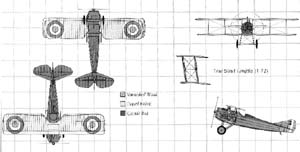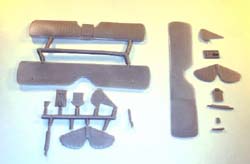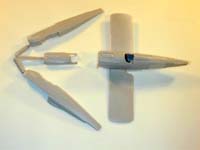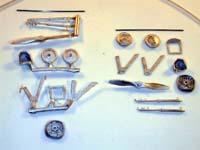Pegasus 1/72 SPAD XII Ca.1 Cannon | | History The cannon armed SPAD came to life in late 1916 after George Guynemer approached Louis Bechereau (S.P.A.D.'s chief designer) about arming a SPAD fighter with a cannon. The first official mention of the SPAD XII was in reports dated 10 December 1916. The SPAD XII was similar in appearance to the Spad VII, however it was larger and heavier. The SPAD XII was powered by a 200 hp Hispano-Suiza 8C engine with a 37mm Hotchkiss shell-firing cannon mounted between the cylinder banks, firing through the propeller hub. A synchronized Vickers machine gun was mounted on the upper fuselage decking offset to the starboard in front of the cockpit.  The wing area increased from 192 sq.ft (17.85 meters) to 217 sq. ft (20.20 meters). The wings had rounded wing tips and a slight forward stagger. The tail surfaces were also more rounded than the PAD VII. The weight increased by 407 pounds (890 kg) with the cannon accounting for most of this increase. The cannon weighed 99 pounds (45 kg) and the 12 shells weighed 22 pounds (10 kg). The wing area increased from 192 sq.ft (17.85 meters) to 217 sq. ft (20.20 meters). The wings had rounded wing tips and a slight forward stagger. The tail surfaces were also more rounded than the PAD VII. The weight increased by 407 pounds (890 kg) with the cannon accounting for most of this increase. The cannon weighed 99 pounds (45 kg) and the 12 shells weighed 22 pounds (10 kg). Because the cannon extended into the cockpit between the pilot's legs, a traditional control column could not be fitted. Per Guynemer's recommendations, a Deperdussin-style control system was used to operate the elevators and ailerons. Guynemer personally carried out much of the testing and on 27 July 1917, he scored his first victory in the SPAD XII. He destroyed an Albatros two-seater with one cannon shell and eight rounds from his Vickers. His second victory came the next day with a D.F.W. falling from hits by two cannon shells and 30 Vickers rounds. 300 SPAD XIIs were ordered into production but it is doubtful that number was ever reached. It is believed that one or two SPAD XIIs were assigned to the best pilots in various Escadrilles. The SPAD XII was reportedly difficult to fly even for the most experienced pilots. Aiming the cannon used a great deal of skill and some pilots used tracers from the Vickers as a sighting weapon. The cannon also had a heavy recoil and filled the cockpit with smoke after each shot. And since the cannon fired only one round at a time, reloading in combat was extremely difficult. Several well known aces did achieve some success with the Spad 12. Guynemer scored four of his victories in the XII, Fonck had 11 of his total. Madon, Deullin,  Chavannes, de Marmier and Battesti all had success with the SPAD XII. Chavannes, de Marmier and Battesti all had success with the SPAD XII. The Kit The PEGASUS kit is molded in the usual light grey plastic and consists of 12 plastic parts, 10 white metal parts, a short piece of round metal for cabane struts, a length of strut material, a decal sheet and a two sided instruction sheet with an exploded drawing. The parts are well molded with some flash but a light sanding takes care of the situation very quickly. Since I have two kits, I have shown the kit as it comes out of  the box and how it looks cleaned up. The fuselage is held together with scotch tape for the photo. Sand very carefully on the trailing edge so as not to lose the delicate scalloped edge. The machine gun is molded plastic and unusable. It appears the breech is molded into the kit and the front half of the machine gun is provided. This area calls for a metal gun if the machine gun is used at all. Some pilots removed the Vickers gun to lessen the nose heaviness of the plane. The metal parts are clean and crisp and require very little cleaning. The interior parts are well done and the instrument shelf is very accurately molded in metal. the box and how it looks cleaned up. The fuselage is held together with scotch tape for the photo. Sand very carefully on the trailing edge so as not to lose the delicate scalloped edge. The machine gun is molded plastic and unusable. It appears the breech is molded into the kit and the front half of the machine gun is provided. This area calls for a metal gun if the machine gun is used at all. Some pilots removed the Vickers gun to lessen the nose heaviness of the plane. The metal parts are clean and crisp and require very little cleaning. The interior parts are well done and the instrument shelf is very accurately molded in metal.  It appeared to me that the attachment points on the kit are smaller that past kits. The side walls are thinner and only minor Dremel work will be required to thin the fuselage. It appeared to me that the attachment points on the kit are smaller that past kits. The side walls are thinner and only minor Dremel work will be required to thin the fuselage. I do not have any drawings of the SPAD XII to check the accuracy of the dimensions. From the few photos I have of the plane, the louvers and access panels are correctly represented. Even the characteristic teardrop shaped cylinder bank fairings on the SPAD XIII are eliminated as per the XII. Checking the dimensions against a SPAD VII, the larger wing area is noted and the more rounded features of the wings and tail surfaces are apparent.  The decal sheet is for the fourth ranking French Air Ace, Georges Maddon during the summer of 1917. The sheet is well done with the blue roundel circles as a separate decal. A color guide and explanation is on the side of the box and this is shown in detail on the back of the box. The decal sheet is for the fourth ranking French Air Ace, Georges Maddon during the summer of 1917. The sheet is well done with the blue roundel circles as a separate decal. A color guide and explanation is on the side of the box and this is shown in detail on the back of the box. Conclusion This is the 33rd 1/72 PEGASUS kit released since about 1985 and it cost me L11.99 or about $15 US. The kit number is 2021. I am pleased with the quality of my kits and I estimate no more than 15 hours in construction. | 


 




|